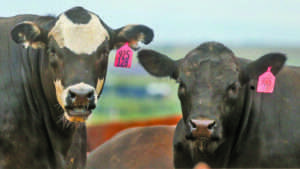KCUR | By Stephen Koranda
A task force is asking Kansas ranchers to take an online survey to find out where the shortage is most severe.
TOPEKA, Kansas — Kansas, a state that relies heavily on the cattle industry to power its economy, faces a shortage of the veterinarians that tend to the livestock.
So it’s launched a task force to find how to draw more people who can doctor the livestock driving billions of dollars in economic activity.
Cattle ranching and related businesses employ nearly 39,000 people and contribute an estimated $8.7 billion to the Kansas economy.
The veterinarian shortage poses more than just an inconvenience for people who ranch cattle or run cow-calf operations. If a cow needs a C-section and a vet isn’t available, that can mean a lost calf — and lost revenue.
“If you don’t have a veterinarian that you can contact to provide the various vet services, it can have devastating impacts to your business,” Deputy Kansas Agriculture Secretary Kelsey Olson said.
State officials, the livestock industry and universities are looking for ways to ease the shortage. The Rural Veterinary Workforce Development Task Force is starting with a survey to determine where livestock producers have the greatest need for veterinarians.
Olson said one factor is that many students entering veterinary school are interested in tending to cats and dogs, rather than heifers and hogs.
“We see that taking off,” she said. “Many of the students are coming in with that experience and wanting to specifically focus on small animals.”
In addition, Olson said it’s a challenging job. A rural vet might be on call every weekend. Working in a larger practice in a city can seem more appealing. More staff can share the demands with rotating weekend shifts.
Still, Kansas is doing better at training large animal vets than many other states.
Brad White, a Kansas State University professor and director of the Beef Cattle Institute, said about 25% of the school’s graduates work in mixed or large animal practices. He said the nationwide average is only around 14%.
He’s urging livestock producers to take the survey to help the group find out where veterinary shortages are the most severe. He thinks about it the same way he would treat an animal disease.
“I want to be able to get a diagnosis. I want to know, exactly what are we dealing with?,” White said. “Then I can come up with what’s the best treatment plan.”
Some veterinary programs at K-State already focus specifically on food animals. White said fixing the shortage likely isn’t as simple as growing those programs.
“Is it education? Is it on the supply side? Is it on the demand side? Where is the discrepancy?” he said.
The people taking part in the effort believe it won’t be an easy task to sort all that out.
“I don’t think there’s a quick fix,” said Matt Teagarden, CEO of the Kansas Livestock Association.
Teagarden said scholarship programs that target rural students might help. But first, members of the task force need to know where there’s sufficient demand to sustain a veterinary practice.
It isn’t a long-term solution to recruit or train a new vet then send them to an area where there isn’t enough demand to sustain their business.
“There might be a reason,” Teagarden said, “there isn’t a vet clinic there already.”
Stephen Koranda is the Statehouse reporter and news editor for the Kansas News Service. You can follow him on Twitter @Stephen_Koranda or email him at stephenkoranda (at) kcur (dot) org.
The Kansas News Service is a collaboration of KCUR, Kansas Public Radio, KMUW and High Plains Public Radio focused on health, the social determinants of health and their connection to public policy. Kansas News Service stories and photos may be republished by news media at no cost with proper attribution and a link to ksnewsservice.org.




